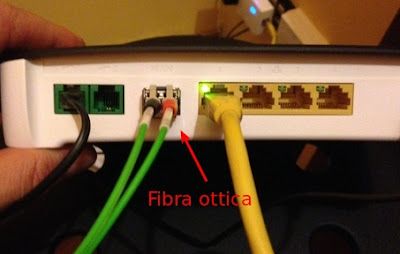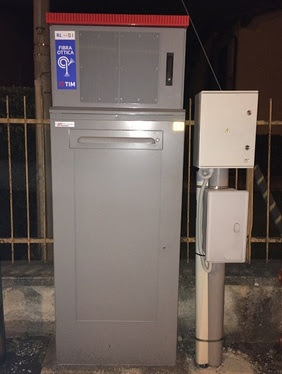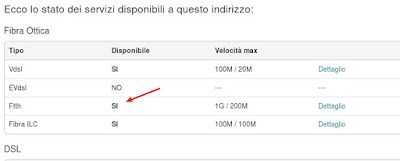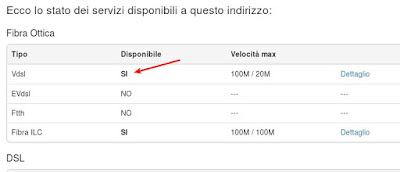what means FTTH, FTTC and VDSL, the abbreviations of the optical fiber that indicate different technologies with different performances.
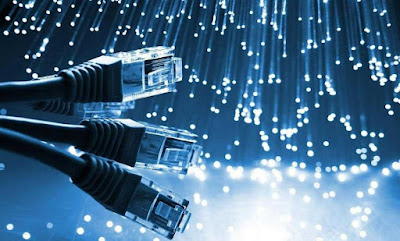 To connect to the Internet at maximum speed, you need to have one fiber optic connection, the only one capable of effectively replacing the now obsolete ADSL line. But when we talk about fiber with an operator (especially if we have to create a new contract), we will hardly have precise information on the type of technology that will be used for the chosen house. Operators (wrongly) speak of “fiber” even when fiber is not, or rather only part of the fiber optic connection is used.
To connect to the Internet at maximum speed, you need to have one fiber optic connection, the only one capable of effectively replacing the now obsolete ADSL line. But when we talk about fiber with an operator (especially if we have to create a new contract), we will hardly have precise information on the type of technology that will be used for the chosen house. Operators (wrongly) speak of “fiber” even when fiber is not, or rather only part of the fiber optic connection is used.In order to be prepared on the types of optical fiber, therefore, we will show you in this guide acronyms most used to identify the fiber optic connection technology. After reading this guide we will know very well how to move and we will no longer be fooled by offers “fiber” that are not (or that are up to a certain point).
READ ALSO -> Best router for fiber: which one to choose
Direct optical fiber: FTTH
If we want to activate a fiber optic connection, the only technology consistent with this definition is FTTH, that is the fiber that reaches the house to replace the old telephone socket. If we are covered by FTTH technology, the fiber optic cable must be placed inside the house, with a socket and a special cable (therefore the intervention of a technician is required to replace the telephone socket). With FTTH it is possible to reach crazy speeds: modern lines offer up to 2.5 Gigabits per second (2500 Mega), but in most cases the standard Gigabit speed (1 Gbps or 1000 Mega) is provided.
Once the socket has been fixed, all we have to do is connect the fiber modem offered by the operator to take advantage of the high-speed signal without using the copper wires (the twisted pairs used for the telephone and ADSL).
In large cities it is possible to find this type of technology with relative ease (operators have invested heavily in this regard), while in smaller municipalities laying the optical fiber to make it available in FTTH is often counterproductive for business, because there are not enough users able to guarantee a return on investment. To compensate for this possibility (considering that there are really many small and medium-sized municipalities in Italy) it was decided to use another type of technology with the fiber optic cable, which we can identify as “mixed” technology.
To find out in detail the type of FTTH used, we can also read our guide FTTH Fiber Optic Types: Which Is Best?
Mixed copper fiber: FTTC, FTTCab, FTTS, FTTB or VDSL
In order to be able to offer contracts at higher speeds than ADSL in small and medium-sized municipalities, operators have focused on mixed copper fiber technology, that is to bring the optical fiber up to the distribution cabinet (present in a street, inside the building or at the intersection of a neighborhood), and then serve individual users via the existing copper cable. In fact, with this technology it is not necessary to change the telephone socket, that of the telephone and ADSL is already good for the FTTC).
This type of fiber cannot properly be defined as optical fiber, but it is a good compromise to be able to exceed the speeds offered by ADSL with minimal disturbance on the part of the user (who can also choose the modem to connect). Leveraging technology mixed copper fiber we can navigate at speeds up to 300 Megabits per second (in download), a decisive step forward compared to the speed offered by the old ADSL.
To see if this type of technology is present, all we have to do is analyze the wardrobes near the house or near the building: for some years they have modified the wardrobes to make them identical to those present below, with the upper part often labeled as “TIM optical fiber”.
If we notice this type of closet under your home or near your neighborhood, you will most likely benefit from FTTC technology.
Deepening on VDSL: what does it mean?
With VDSL you identify the type of connection with which you use both copper and optical fiber to connect to the Internet. In fact it is synonymous with FTTC, since they identify the same type of technology. While operators prefer to talk about fiber or FTTC, in the modems we will see the writing VDSL2 appear when you use FTTC technology (only VDSL2 is used in Italy, so when we talk about VDSL we are always talking about VDSL2). VDSL2 has various profiles that can be activated at the telephone exchange or cabinet level; based on the active profile on our line we can benefit from a different connection speed:
- 8b: up to 50 Megabits per second in download
- 17a: up to 100 Megabits per second in download
- 30a: up to 200 Megabits per second in download
- 35b: up to 300 Megabits per second in download
By keeping the socket at home and taking advantage of the VDSL2, we can connect you at speeds once reached only with the FTTH fiber, without waiting for them to lay the cable for the direct optical fiber.
Better FTTH or FTTC?
If we can choose it is obviously preferable to focus on optical fiber (FTTH) because we will get less noise and interference, we will travel at stable speeds and we will be able to benefit from future line updates without having to change everything again.
If only the FTTC is available in our area and so far we have used an ADSL connection, it is worth taking advantage of it: the jump in speed compared to ADSL justifies any additional cost or cost to exit the old contract.
Fiber coverage check
Before entering into a new contract with an operator for optical fiber, we check on the Fibermap website if our address is covered by fiber services.
Once the site is open, all we have to do is select the region, the province, the city and finally the home address to check your line. If we are reached by the FTTH fiber we will see the related item as active.
If, on the other hand, we are covered by FTTC we will have to check the VDSL voice to be reached by the mixed optical fiber.
By clicking on the button Detail next to the relevant item that you can activate, you will get valuable information on the distance from the cabinet, the cabinet code, the completion of the work (if not yet finished) and the average speed that you can obtain once connected in FTTH or FTTC.
To learn more we can also read our guide Best Optical Fiber: check coverage and offers.
Conclusions
The optical fiber will allow you to browse quickly at home or in the office, relegating the problems of ADSL to the past. If we have the opportunity we immediately activate the FTTH if available at our address; if there is no direct optical fiber, we can also “settle” with the FTTC, especially if we manage to exceed 80 Mega in download.
To discover the new evolutions of VDSL and to connect a new FTTH fiber modem we advise you to read our guides EVDSL: the alternative to optical fiber for fast Internet or How to use the FRITZ! Box modem on an FTTH fiber optic network.

